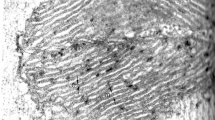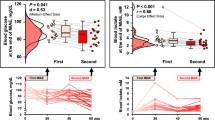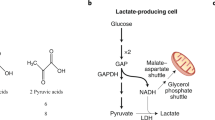Abstract
OBJECTIVE: To determine the relationship between muscle-derived lactate at fatigue and earlier onset of fatigue in the obese rat subjected to intense exercise. DESIGN: Rats were subjected to a short, intense exercise protocol on a treadmill. Blood was drawn from hind leg vein and artery during exercise and up to 1 h afterwards. Assuming an exercise respiratory quotient of 1.0, the extra carbon dioxide released was computed and assumed to be displaced by equimolar amounts of lactic acid produced by the rat during exercise. SUBJECTS: Conscious female adult Zucker lean and Zucker obese rats. MEASUREMENTS: Oxygen consumption and carbon dioxide release. Lactate and bicarbonate levels in hind leg venous and arterial blood; balances were estimated by measuring blood flow with fluorescent microspheres. Lactate levels in periovaric white adipose tissue were also measured. RESULTS: Muscle released, during exercise and post exercise roughly 2.3 mmol lactate in lean rats and 2.6 mmol in obese ones. Of these amounts, hind leg lactate release accounted for 0.40 mmol in lean rats and only 0.11 in the obese ones, which showed a release of acid (mainly lactate) elsewhere in the rats totalling about 19.9 mmol CO2 in lean rats and 4.4% in the obese ones; that is both hind quarters accounted for only 17.2% of all lactate produced in the lean rats and 4.4% in the obese ones. The amount of lactate produced by the rats was roughly similar. White adipose tissue lactate levels (in the basal state and after exercise) were much higher than could be expected from blood sources alone, indicating an active production of lactate. CONCLUSION: Fatigue appears earlier in the obese rats than in lean ones because of loss of buffering ability caused by massive extra-muscular glycolysis (probably in adipose tissue) and lactate production triggered by exercise-induced adrenergic stimulation.
This is a preview of subscription content, access via your institution
Access options
Subscribe to this journal
Receive 12 print issues and online access
$259.00 per year
only $21.58 per issue
Buy this article
- Purchase on Springer Link
- Instant access to full article PDF
Prices may be subject to local taxes which are calculated during checkout
Similar content being viewed by others
Author information
Authors and Affiliations
Rights and permissions
About this article
Cite this article
Ardévol, A., Adán, C., Remesar, X. et al. Lactate-bicarbonate interrelationship during exercise and recovery in lean and obese Zucker rats. Int J Obes 21, 333–339 (1997). https://doi.org/10.1038/sj.ijo.0800409
Received:
Revised:
Accepted:
Issue Date:
DOI: https://doi.org/10.1038/sj.ijo.0800409



